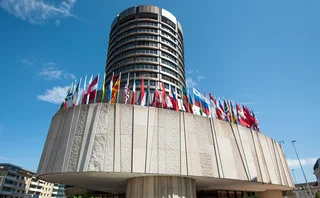
Questioning convergence
The Australian accounting industry’s move towards convergence with international standards may not be good news for the country’s securitisation markets. Alice Hales reports.

As it happens, the worst-case scenario never materialised because computer boffins managed to correct the anomaly in time. Now, what on earth has the Y2K bug got to do with the Australian securitisation market? The truth is that there is a strong similarity between the insecurity that Y2K caused a few years ago and the uncertainty that the convergence with international accounting standards (IAS) is causing to the country’s securitisation professionals right now.
Just as then, nobody is quite sure how the adoption of International Financial Reporting Standards (IFRS, currently known as IAS), due to come into effect in 2005, will affect the market. But inconsistencies in how different countries interpret accounting standards related to special-purpose vehicles (SPV), through which securitisation deals are issued, are a cause for concern.
It has long been established that one of the principal benefits of securitisation is that it allows issuers to move assets off the balance sheet. For financial institutions, obliged to hold regulatory capital against their assets, this has been a significant advantage. In Europe, however, this benefit has all but been removed due to the International Accounting Standards Board’s (IASB) interpretation on the consolidation of special-purpose entities (SPE) – the Standing Interpretations Committee (SIC) 12 guidelines - that has forced companies to move securitisation vehicles back on to their balance sheets.
The thinking behind the IASB’s regulations was to try to prevent companies hiding bad assets and debts in SPEs, which allows firms to make their balance sheet look healthier than it really is, an issue that came to light with the Enron scandal late in 2001.
Although the Urgent Issues Group (UIG) 28, Australia’s equivalent to SIC 12, has the same wording, Australian regulators have so far allowed for a different interpretation of the guidelines. But with Australia’s regulator, the Australian Prudential Regulation Authority (APRA), keen to align with international practices on accounting, it seems certain that Australia will also have to change its approach to the consolidation of SPVs.
“ The reason that harmonisation of international accounting standards is causing concern to securitisation profes- sionals comes down to a difference of interpretation,” says Martin McGrath, a partner in the financial services group at KPMG, in Sydney. This difference can be illustrated through an example of a residential mortgage-backed deal, he says. In this case, an institution sells the loans to a SPE, which funds the purchase by issuing notes to third parties. The seller will typically hold an income note, which allows it to receive any residual income in the SPE, but the actual risk arising from the loans has been transferred to the SPV and the noteholders. In Australia, as long as there is a clear transfer of risk, the seller has not typically been required to consolidate the SPE on to its balance sheet.
UIG 28 stipulates four situations in which an SPE would normally be consolidated. One of these is where an entity has rights to obtain the majority of the benefits of the activities of the SPE and may therefore be exposed to risks related to the SPV’s activities. “When interpreting this clause in Australia, we have typically focused on the gross benefits in the SPE, that is, principal and interest flows, and the gross credit risk,” continues McGrath. “However, the interpretation adopted in Europe has focused on the residual income. As I mentioned, the seller of the assets holds an income note, which means that they can earn residual interest, and under that interpretation they would be required to consolidate.”
Any harmonisation with the European interpretations could have a significant impact on Australian issuers of asset-backed securities, adds McGrath. “If Australia goes down that route, it will blow the balance sheet up. As to how big an issue that will be in reality, it is still difficult to say. However, I suspect that a lot of corporates would say that bringing assets back on balance sheet could impact their gearing ratios to an extent that it could really affect their future borrowing capacity,” he says.
Fabienne Michaux, director of Standard & Poor’s Australian structured finance ratings group in Melbourne, believes there are potential benefits as well as costs from adopting international standards. “The convergence of standards should be positive for the Australian market because it will improve comparability of financial reports across markets,” she asserts. “This is important given the size of the Australian market and its reliance on offshore
markets.” From a ratings perspective, accounting issues will not affect the rating outcomes of securitisation transactions, or the ownership status of the assets that may be transferred to the SPE, she says. “From an issuer’s perspective, however, the potential accounting changes might have an impact on their overall incentive to securitise. Securitisation offers companies many benefits, one of which has historically been off-balance sheet treatment, but how important a factor this is in determining whether to securitise or not depends on each issuer.”
Patrick Winsbury, Singapore-based senior analyst for Moody’s Investor’s Service financial institutions group, argues that so long as securitisation remains an important funding source, banks will continue to issue deals. But he adds that the adoption of new rules could affect the amount of regulatory capital banks have to hold, which could affect volumes. “Currently, banks can get regulatory capital arbitrage from securitisation, as it enables them to originate greater volumes of loans without needing to hold much regulatory capital against those assets. But if the banks are forced to hold more capital due to consolidating their deals on balance sheet, I would guess that you might not see so much growth in the market.”
And it looks as if the amount of regulatory capital banks have to hold could be severely affected if APRA changes its rules, says Brian Salter, a Sydney-based partner at Clayton Utz and former chairman of the Australian Securitisation Forum. “If the SIC 12 interpretation is applied, a number of structures that have been off balance sheet to date will be brought back on to the balance sheet of Australian financial institutions,” explains Salter. “In addition, under the Australian Prudential Standard 120 regulation that governs the securitisation of financial institutions, if an asset is consolidated, the financial institution cannot obtain relief from holding capital against that asset, so there is more at stake than just balance sheet implications; it will affect the amount of capital financial institutions need to hold.”
Australian securitisation practitioners are continuing in their attempts to persuade APRA to change its mind, on the basis that if it can be established that the seller bears no risk in relation to the assets in a SPE, even though it holds an income note, it should not need to hold capital against the asset. “APRA will only change the rules if it is convinced that doing so will not create loopholes. It is my belief that they should be convinced that there is no reason to make issuers hold capital against assets included within the group as a result of a technical accounting interpretation,” says KPMG’s McGrath.
Unless APRA changes the rules, which would effectively go against the international train of thought on consolidation, Australian issuers will have to deal with the effects of consolidation on their balance sheet and its effects on the amount of capital they need to hold against assets. But due to another debate currently going on in the accounting world, one that could again change the approach to consolidation of SPEs and securitisation, banks cannot even start to prepare themselves and to look at their different funding options.
Although it does not refer specifically to consolidation, possible changes to IAS 39 – an accounting standard for the recognition and measurement of financial instruments – could be extremely relevant because it covers the IASB’s approach to the derecognition of assets and whether this can be achieved by a sale. Put simply, if by selling assets to an SPE through securitisation, an issuer is able to meet the IASB’s criteria and therefore have that asset derecognised, the implication is that they would not need to hold any more capital against that asset.
That would be considered good news if it wasn’t for contradictions in IAS 39 that would make it extremely difficult to get an asset derecognised. For example, many securitisation transactions are structured with a call option, to allow the issuer to buy back any remaining loans from the SPE that have not yet been fully realised. But even though only a small portion of the original portfolio would be bought back, this would constitute ‘continued involvement’ with the asset, and therefore such a deal would not meet the derecognition criteria.
It is a major inconsistency in IAS 39, and although the IASB is considering making changes next year, this still does not deal with a fundamental problem, bankers say. The IASB has one set of rules under which entities can remove securitised assets from the balance sheet (IAS 39) and another that does exactly the opposite (SIC 12). At present, there are no guidelines that set out how IAS 39 and SIC 12 interact with each other and until there are, securitisation professionals, and not just those in Australia, cannot really be sure how convergence will affect the markets from 2005.
Phil Richards, treasurer of Macquarie Securitisation in Sydney, says that although the uncertainty surrounding accounting makes it difficult to plot a firm course of action, Macquarie is preparing for a number of scenarios. “Given that there is a lack of clarity about what convergence of IAS will mean in reality, we won’t be making any decisions related to that until there is more certainty,” he explains. “But with respect to alternative structures, yes, some alternatives are on the ‘to be reviewed when things are clearer’ list.”
Perhaps one ray of hope for Australian issuers, particularly of mortgage-based securities (MBS) deals, can be found in what the UK issuers are doing. Although UK mortgage lenders can no longer get off-balance-sheet treatment from securitisation, it seems as if HBOS – formed in 2001 from the merger of the Halifax Building Society and the Bank of Scotland – has found an alternative means of raising funds that avoids the potentially harsh capital requirements imposed on securitisation.
In mid-July, HBOS raised E3 billion ($3.4 billion) from the first covered bond by a UK borrower. Similar to a German Pfandbriefe, the seven-year deal – underwritten by Citigroup, Goldman Sachs and Dresdner Bank – was backed by mortgages that stay on the balance sheet rather than being transferred to an SPV. The biggest advantages to HBOS in doing a covered bond were the pricing – which at 10 basis points over the mid-swap rate is around 10bp inside a traditional MBS deal – and the capital treatment. Under international bank guidelines, issuers of covered bonds get 20% risk-weighting treatment, significantly less than the 50% carried by mortgage bonds.
Given that MBS deals typically account for around 90% of securitisation volumes in Australia, perhaps a viable alternative source of funds has been found for issuers should the convergence of IAS have too many negative effects.
Only users who have a paid subscription or are part of a corporate subscription are able to print or copy content.
To access these options, along with all other subscription benefits, please contact info@risk.net or view our subscription options here: http://subscriptions.risk.net/subscribe
You are currently unable to print this content. Please contact info@risk.net to find out more.
You are currently unable to copy this content. Please contact info@risk.net to find out more.
Copyright Infopro Digital Limited. All rights reserved.
You may share this content using our article tools. Printing this content is for the sole use of the Authorised User (named subscriber), as outlined in our terms and conditions - https://www.infopro-insight.com/terms-conditions/insight-subscriptions/
If you would like to purchase additional rights please email info@risk.net
Copyright Infopro Digital Limited. All rights reserved.
You may share this content using our article tools. Copying this content is for the sole use of the Authorised User (named subscriber), as outlined in our terms and conditions - https://www.infopro-insight.com/terms-conditions/insight-subscriptions/
If you would like to purchase additional rights please email info@risk.net
More on Regulation
Basel III endgame: why moving fast might prove better for banks
Republicans are pushing for reproposal, but a rapid finalisation may prove less far-reaching
Isda pushes to ‘decouple’ Simm calibration from model changes
Emir 3.0 prompts effort to separate risk-weight revisions from methodology updates
Basel war on window-dressing may smooth liquidity, at a price
Changes to G-Sib charge could curb year-end repo volatility, but also cut balance sheet capacity
One year on, regulators still want a cure for bank runs
Broad support for higher outflow assumptions on uninsured deposits, but that won’t save insolvent banks
Watchlist and adverse media monitoring solutions 2024: market update and vendor landscape
This Chartis report updates Watchlist monitoring solutions 2022 and focuses on solutions for sanctions (name and transaction) screening and monitoring adverse media and its related elements
Basel Committee reviewing design of liquidity ratios
Focus on LCR and NSFR after Silicon Valley Bank and Credit Suisse, but assumptions may not change
Risk, portfolio margin, regulation: regtech to the rescue
A white paper outlining the complexity of setting the course for risk, margin and regulation
Prop shops recoil from EU’s ‘ill-fitting’ capital regime
Large proprietary trading firms complain they are subject to hand-me-down rules originally designed for banks
Most read
- Breaking out of the cells: banks’ long goodbye to spreadsheets
- Too soon to say good riddance to banks’ public enemy number one
- Industry calls for major rethink of Basel III rules







